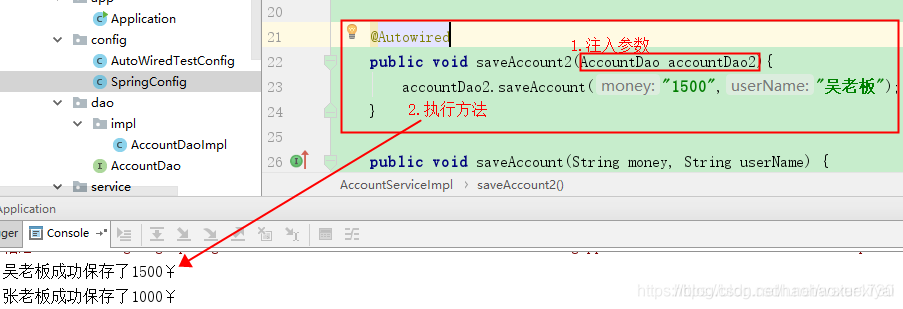- Mysql SQL优化
- vanna:基于RAG的text2sql框架
- 如何在 Ubuntu 18.04 上使用 Docker 构建和部署 F
- LLM-AI大模型介绍
- Docker - 基本概念、与虚拟机的区别、架构、镜像操作、容器操作、
- SpringBoot整合Druid数据库连接池&多数据源&am
- 如何为PostgreSQL设置自增主键?
- mongodb中的多表查询aggregate中排序不是按全表排序,而是
- springboot实现多数据源
- mysql如何自定义自增主键值,以及所遇到的不生效问题
- MySQL中的sql优化
- Python 操作 json 数据
- QT学习之路——Qt QMySQL driver not loaded
- 已解决org.springframework.dao.DataAcce
- 国产高云FPGA:OV5640图像视频采集系统,提供Gowin工程源码
- 深度解析预训练权重的本质和作用:你真的了解它们吗?
- 【爬虫实战】python文本分析库——Gensim
- 【Docker】Docker比虚拟机快的原因、ubuntu容器、镜像的
- SpringBoot集成EasyExcel 3.x:高效实现Excel
- Error running ‘Tomcat‘: Unable to o
- Oracle表结构转成MySQL表结构
- lua学习笔记20(lua中一些自带库的学习)
- 分割一切?手把手教你部署SAM+LabelStudio实现自动标注
- 算法D11 | 栈和队列练习 | 20. 有效的括号 1047. 删除
- 超简单的正则表达式从入门到精通
- Linux系统部署SQL Server结合内网穿透实现公网访问本地数据
- vue2项目导出操作实现(后端接口导出、前端直接做导出)
- SpringBlade dict-bizlist SQL 注入漏洞复现
- Java 正则表达式匹配
- Docker进阶:容器与镜像的导入和导出
文章目录
- @Autowired注解作用在方法上
- @Autowired注解作用在属性上
- @Autowired注解的使用和注入规则
- 1.使用在变量域上面
- 2.@Autowired注解使用在构造器上面
@Autowired表示一个属性是否需要进行依赖注入,可以使用在属性、普通方法上、构造方法上。注解中的required属性默认是true,如果没有对象可以注入到属性,则会报出异常;
@Autowired加在某个属性上,spring会从ioc容器中找到bean对象注入到属性上,如果找到多个该类型的Bean对象,则再根据属性的名字从多个Bean对象中确认一个;
@Autowired写在set()方法上,在spring会根据方法的参数类型从ioc容器中找到该类型的Bean对象注入到方法的行参中,并且自动反射调用该方法(被@Autowired修饰的方法一定会执行),所以一般使用在set方法中、普通方法不用;
@Autowired使用在构造方法中:根据构造方法的形参、形参名,从ioc容器中找到该类型的Bean对象,注入到构造方法的形参中,并且执行该方法;
//构造方法 @Autowired public Bean03(Bean04 bean04) { System.out.println("11111111111111"); } //属性上 @Autowired Bean04 bean04; //set方法 @Autowired public void setBean04(Bean04 bean) { this.bean04 = bean; } //普通方法 @Autowired public void commonMethod(Bean04 bean04){ System.out.println("普通方法的执行"); }@Autowired使用在构造方法上的细节
在同一个类上有多个构造方法上使用了@Autowired,默认情况下会报错;
解决方法:可以把@Autowired的属性required设置成为false,此时spring会自己选择使用哪一种构造方法;
spring在上述情况下的选择规则:
1.会优先考虑参数多的
(先ByType找到多个该类型的bean,再ByName进行注入)
2.如果多个类型的bean按照ByName无法注入,则去考虑参数少的进行注入,依次类推;
3.在参数个数相同、ByName,也可以注入的情况下,按照构造方法的书写顺序进行选择;
@Autowired注解作用在方法上
(1)该方法如果有参数,会使用autowired的方式在容器中查找是否有该参数
(2)会执行该方法

所以如果把@Autowired放在setter方法上,就等于给对象的属性赋值
@Autowired注解作用在属性上
即为在容器中创建对象时给该项属性注入值,效果同@Autowired在setter方法。
@Autowired注解的使用和注入规则
作为一个Spring开发者对@Autowired注解必定是非常了解了, 顾名思义自动装配,应该是Spring会自动将我们标记为@Autowired的元素装配好,与其猜测不如看看它的定义:
@Target({ElementType.CONSTRUCTOR, ElementType.METHOD, ElementType.PARAMETER, ElementType.FIELD, ElementType.ANNOTATION_TYPE}) @Retention(RetentionPolicy.RUNTIME) @Documented public @interface Autowired { boolean required() default true; }很明显这个注解可以用到构造器,变量域,方法,注解类型和方法参数上。文档上这样描述:将一个构造器,变量域,setter方法,config方法标记为被Spring DI 工具自动装配。换句话说,在Spring创建bean的过程中,会为这个bean中标有@Autowired注解的构造器,变量域,方法和方法参数中自动注入我们需要的已经在Spring IOC容器里面的bean,,而无需我们手动完成,并且注入的bean都是单实例,也就是在两个bean中都依赖第三个bean,那么这两个bean中注入的第三个bean会是同一个bean(JVM中指向的地址相同)。
在@Autowired注解里面有一个required属性,该属性默认为true,当为true时,表示去Spring IOC中查找相应的bean,如果找不到,则会报错,如果为false时,表示去Spring IOC中查找相应的bean,如果找不到,则直接忽略,不再进行注入。
@Autowired注解的注入规则:默认按照类型进行注入,如果IOC容器中存在两个及以上的相同类型的bean时,根据bean的名称进行注入,如果没有指定名称的bean,则会报错。
可以使用@Qualifier(“wheel”)来使用指定id的bean,也可以在注入bean时,添加@Primary注解,优先添加一个bean,其规则如下:
如果指定添加了@Qualifier(“wheel”)则按照指定的bean id进行添加(优先级最高),找不到则直接报错。如果没有添加@Qualifier而添加了@Primary注解,则首先添加标注了@Primary注解的bean。当即存在@Qualifier注解也存在@Primary注解注解,则按照@Qualifier指定的bean id注入,找不到直接报错。
下面让我们来看一下@Autowired的用法:
1.使用在变量域上面
这个相信大家都已经清楚了,Spring会帮我们注入我们想要的bean,看下面的例子:
@Component public class Wheel { } @Component public class Car { @Autowired private Wheel wheel2; public Wheel getWheel() { return wheel2; } public void setWheel(Wheel wheel2) { this.wheel2 = wheel2; } } @ComponentScan({"it.cast.circularDependency"}) public class AutowiredConfig { }下面进行测试,打印的结果显示可以拿到Wheel类,说明@Autowired注解在IOC容器中只有一个类型的bean时,按照类型进行注入。
@Test public void AutowiredConfigTest(){ AnnotationConfigApplicationContext context = new AnnotationConfigApplicationContext(AutowiredConfig.class); Car bean = context.getBean(Car.class); System.out.println(bean.getWheel()); } //打印结果: // it.cast.circularDependency.Wheel@3eb25e1a下面看一下当IOC容器中有两个Wheel类型的bean时的情况,改造Wheel类,增加一个属性标识用于记录向Car类中注入的哪个Wheel的bean,在AutowiredConfig配置类中添加一个bean,bean的名称默认为方法名,也就是wheel1。
@Component public class Wheel { private int num = 2; //通过包扫描的方式注入的bean的num值为2 public int getNum() { return num; } public void setNum(int num) { this.num = num; } } @Component public class Car { @Autowired private Wheel wheel3;//将变量名改成wheel3,IOC容器中Wheel类型的bean的名称只有wheel和wheel1 public Wheel getWheel() { return wheel3; } public void setWheel(Wheel wheel3) { this.wheel3 = wheel3; } } @Configuration @ComponentScan({"it.cast.circularDependency"}) public class AutowiredConfig { @Bean public Wheel wheel1(){ Wheel wheel = new Wheel();//通过配置类注入bean的方式num值为0 wheel.setNum(0); return wheel; } }这时在Spring IOC中有两个Wheel类型的bean了,Car在注入Wheel类型的bean时,会根据变量名wheel3去找,也就是说会去找类型为Wheel,名称为wheel3的bean,显然是找不到的,也就会报错。
Exception encountered during context initialization - cancelling refresh attempt:
org.springframework.beans.factory.UnsatisfiedDependencyException:
Error creating bean with name ‘car’:
Unsatisfied dependency expressed through field ‘wheel3’;
nested exception is org.springframework.beans.factory.NoUniqueBeanDefinitionException:
No qualifying bean of type ‘it.cast.circularDependency.Wheel’ available:
expected single matching bean but found 2: wheel,wheel1
org.springframework.beans.factory.UnsatisfiedDependencyException:
Error creating bean with name ‘car’: Unsatisfied dependency expressed through field ‘wheel3’;
nested exception is org.springframework.beans.factory.NoUniqueBeanDefinitionException:
No qualifying bean of type ‘it.cast.circularDependency.Wheel’ available:
expected single matching bean but found 2: wheel,wheel1
上面为报错的日志打印,大致意思说的在创建名称为car的bean时,不能为变量域wheel3完成属性注入,因为找到了两个bean,分别是wheel和wheel1。
如果我们把Car中的wheel3换成wheel就可以完成注入了,而且注入的bean是通过包扫描注入IOC的bean:
@Component public class Wheel { private int num = 2; //通过包扫描的方式注入的bean的num值为2 public int getNum() { return num; } public void setNum(int num) { this.num = num; } } @Component public class Car { @Autowired private Wheel wheel;//将变量名改成wheel1,IOC容器中Wheel类型的bean的名称只有wheel和wheel1 public Wheel getWheel() { return wheel; } public void setWheel(Wheel wheel3) { this.wheel = wheel; } } @Configuration @ComponentScan({"it.cast.circularDependency"}) public class AutowiredConfig { @Bean public Wheel wheel1(){ Wheel wheel = new Wheel();//通过配置类注入bean的方式num值为0 wheel.setNum(0); return wheel; } }在测试类中打印num值看看注入的是哪个bean:
@Test public void AutowiredConfigTest(){ AnnotationConfigApplicationContext context = new AnnotationConfigApplicationContext(AutowiredConfig.class); Car bean = context.getBean(Car.class); System.out.println(bean.getWheel().getNum()); } //打印结果: // 2那么就验证了上面所说的注入规则:默认按照类型进行注入,如果IOC容器中存在两个及以上的相同类型的bean时,根据bean的名称进行注入,如果没有指定名称的bean,则会报错。
@Autowired注解使用在变量域中还可以解决循环依赖的问题,循环依赖问题就是A对象中注入了B对象,B对象中注入了A对象,循环依赖在面试Spring这一块的知识应该经常会被问题,关于循环依赖的问题,在后面的博客中会更新。
2.@Autowired注解使用在构造器上面
@Autowired使用在构造器上面有几条需要特别注意的点:
1.@Autowired标注在构造器上面不能解决循环依赖构造的问题
2.@Autowired可以标注在同一个类的多个构造器上面,但是required属性必须都为false,当required有一个为true时,不允许其他构造器标有@Autowired注解,即使required属性为false也不行。
@Component public class A { private B b; private C c; @Autowired public A(B b, C c) { System.out.println("b=" + b + ", c=" + c); this.b = b; this.c = c; } } @Component public class B { } @Component public class C { } //打印结果: // b=it.cast.circularDependency.B@68e965f5, c=it.cast.circularDependency.C@6f27a732@Autowired标注在构造器上面,在B创建的过程中,会去Spring IOC中拿到需要的注入的bean,完成B的创建,其实在只有一个构造器的情况中,@Autowired可以不加,因为Spring内部有自动推断构造器的能力,这个如果想了解自动推断构造器的同学可以自行百度。
下面看一个构造器循坏依赖的案例:
@Component public class C { private B b; public C(B b) { this.b = b; } } @Component public class B { private C c; public B(C c) { this.c = c; } }Spring目前不能解决构造器的循环依赖,所以在项目中使用的时候要格外注意一下,错误日志:
org.springframework.beans.factory.UnsatisfiedDependencyException:
Error creating bean with name ‘a’ defined in file
[E:\IdeaProjects\javaBasis\spring\target\classes\it\cast\circularDependency\A.class]:
Unsatisfied dependency expressed through constructor parameter 0;
nested exception is org.springframework.beans.factory.UnsatisfiedDependencyException:
Error creating bean with name ‘b’ defined in file
[E:\IdeaProjects\javaBasis\spring\target\classes\it\cast\circularDependency\B.class]:
Unsatisfied dependency expressed through constructor parameter 0;
nested exception is org.springframework.beans.factory.UnsatisfiedDependencyException:
Error creating bean with name ‘c’ defined in file
[E:\IdeaProjects\javaBasis\spring\target\classes\it\cast\circularDependency\C.class]:
Unsatisfied dependency expressed through constructor parameter 0;
nested exception is org.springframework.beans.factory.BeanCurrentlyInCreationException:
Error creating bean with name ‘b’:
Requested bean is currently in creation: Is there an unresolvable circular reference?
下面看一下关于多个@Autowired标注的构造器的案例:
@Component public class A { private B b; private C c; @Autowired(required = false) public A(B b) { this.b = b; } @Autowired public A(B b, C c) { System.out.println("b=" + b + ", c=" + c); this.b = b; this.c = c; } } @Component public class B { } @Component public class C { }上面已经说到,如果@Autowired注解的属性required为true时,不允许再出现其他构造器上面标有@Autowired注解(@Autowired注解的required默认为true,所以上面的会报错)
错误日志为:
org.springframework.beans.factory.BeanCreationException:
Error creating bean with name ‘a’: Invalid autowire-marked constructors:
[public it.cast.circularDependency.A(it.cast.circularDependency.B)].
Found constructor with ‘required’ Autowired annotation:
public it.cast.circularDependency.A(it.cast.circularDependency.B,it.cast.circularDependency.C)
使用下面的写法就不会出现错误了,Spring支持多个构造器有@Autowired注解,但是required属性必须都是false
@Component public class A { private B b; private C c; @Autowired(required = false) public A(B b) { this.b = b; } @Autowired(required = false) public A(B b, C c) { System.out.println("b=" + b + ", c=" + c); this.b = b; this.c = c; } } @Component public class B { } @Component public class C { }关于@Autowired标注在方法上就不多介绍,会首先拿到方法的参数列表,然后根据上面所说的注入规则去Spring IOC中找相应的bean。














